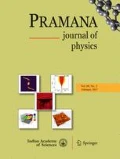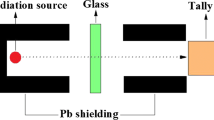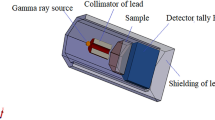Abstract
The bismuth-based non-toxic and lead-free alloys have been investigated for their advanced photon attenuation and photon energy absorption characteristics over wide \(\upgamma \)-ray energy regime from 1 keV to 20 MeV. For this study, we selected five bismuth containing alloys with composition: Bi50Sn\({(50-x)}\)Znx where \(x=0, 10, 20, 30, 40 \,\hbox {wt}.\%\). The mass attenuation coefficient values computed by theoretical approach using the WinXCom software package show marked difference from the mass energy-absorption coefficient values particularly in the energy regime dominated by the Compton effect (CE). Photon interaction (attenuation) effective atomic number \((Z_{\mathrm {PIeff}}\)) and photon-energy absorption effective atomic number \((Z_{\mathrm {PEAeff}})\) values were compared for their mean, maximum and minimum values computed for these alloys. The optimum thickness range analysed using the attenuation and absorption coefficient values indicate saturation with respect to photon energy spanning Compton effect (CE) and pair-production (PP) processes. Kinetic energy released per unit mass of the absorbing material (KERMA) relative to air calculations indicated significant influence of the elemental composition of these alloys in the intermediate photon energy regime. We also performed calculations for the air-KERMA or exposure build-up factors of these Bi–Sn–Zn alloy compositions done within the framework of novel EXABCal programme code. The calculated exposure build-up factor was found to be minimum for the alloy composition Bi50Sn50. Present investigation of photon interaction and photon energy absorption characteristics would be of interest for addressing shielding efficiency of lead-free and environment friendly bismuth containing alloy systems.










Similar content being viewed by others
References
V P Singh and N M Badiger, J. Ceram. 2013, 1 (2012)
B Mavi, Ann. Nucl. Energy 44, 22 (2012)
K Singh, S Singh, A S Dhaliwal and G Singh, Appl. Radiat. Isot. 95, 174 (2015)
K S Mann, Nucl. Instr. Methods A 877, 1 (2018)
O Oyeleke and M Bello, AJMP 2(1), 31 (2019)
M K Halimah, A Azuraida, M Ishak and L Hasnimulyati, J. Non-Cryst. Solids 512, 140 (2019)
N Chanthima, P Prongsamrong, J Kaewkhao and P Limsuwan, Procedia Eng. 32, 976 (2012)
F A Ikraiam, A Abd El-Latif, A Abd El-Azziz and J M Ali, Arab. J. Nucl. Sci. Appl. 42, 287 (2009)
A Akkaş, Acta Phys. Pol. A 129, 770 (2016)
K S Mann, B Kaur, G S Sidhu and A Kumar, Radiat. Phys. Chem. 87, 16 (2013)
A Khanna, S S Bhatti, K J Singh and K S Thind, Nucl. Instr. Methods B 114(3), 217 (1996)
P Limkitjaroeporn, J Kaewkhao, P Limsuwan and W Chewpraditkul, J. Phys. Chem. Solids 72, 245 (2011)
K J Singh, S Kaur and R S Kaundal, Rad. Phys. Chem. 96, 153 (2014)
Abbas J Al-Saadi, Abbas K Saadon and Ibn Al-Haitham, J. Pure Appl. Sci. 27, 201 (2014)
F Akman, M I Sayyed, M R Kaçal and H O Tekin, J. Alloys Compd. 772, 516 (2019)
O Agar, M I Sayyed, F Akman, H O Tekin and M R Kaçal, Nucl. Eng. Technol. 51, 853 (2019)
IARC Monographs on the Evaluation of Carcinogenic Risks to Humans: Inorganic and Organic Lead Compounds, Vol. 87 (2006)
M Bruyneel, J P De Caluwé, J M des Grottes and F Collart, Rev. Méd. Brux. 23(6), 519 (2002)
R M Al-Ashban, M Aslam and A H Shah, Public Health 118, 292 (2004)
A Eid and N Zawia, Neurotoxicology 56, 254 (2016)
F Akman, M R Kaçal, M I Sayyed and H A Karataş, J. Alloys Compd. 782, 315 (2019)
M Kurudirek, N Chutithanapanon, R Laopaiboon, C Yenchai and C Bootjomchai, J. Alloys Compd. 745, 355 (2018)
T P Martinez and M E Cournoyer, J. Radioanal. Nucl. Ch. 249, 397 (2001)
L Gerward, N Guilbert, K B Jensen and H Leving, Radiat. Phys. Chem. 71, 653 (2004)
M J Berger and J H Hubbell 1987/1999, XCOM: Photon Cross Sections Database (version 1.2). Available: https://www.nist.gov/pml/xcom-photon-cross-sections-database. National Institute of Standards and Technology, Gaithersburg, MD, 201899 USA
J H Hubbell and S M Seltzer 1995, NISTIR-5632. Available: https://www.nist.gov/pml/x-ray-mass-attenuation-coefficients. National Institute of Standards and Technology, Gaithersburg, MD, 201899 USA
N Rani, Y K Vermani and T Singh, J. Radio. Prot. 40, 296 (2020)
M I Sayyed, F Akman, V Turan and A Araz, Radiochim. Acta 107(1), 83 (2018)
T Kaur, J Sharma and T Singh, Nucl. Eng. Technol. 3, 1 (2017)
B O Elbashir, M I Sayyed, Shams A M Issa, M G Dong, K A Matori and M H M Zaid, Results Phys. 9, 6 (2018)
R Biswas, H Sahadath, Abdus S Mollah and M F Huq, J. Radiat. Res. Appl. Sci. 9(1), 26 (2016)
ICRU, Radiation Quantities and Units 1980, International Commission on Radiation Units and Measurements Report 33, 7910 Woodmont Avenue, Suite 800, Bethesda, MD 20814
F H Attix, Introduction to radiological physics and radiation dosimetry (Wiley, New York, 1986)
Y Harima, Nucl. Sci. Eng. 83, 299 (1983)
Y Harima, Radiat. Phys. Chem. 41(4\(/\)5), 631 (1993)
M I Sayyed, F Akman and M R Kaçal, Radiochim. Acta 107, 339 (2019)
I O Olarinoye, J. Nucl. Res. Dev. 13, 57 (2017)
I O Olarinoye, R I Odiaga and S Paul, Heliyon 5(7), e02017 (2019)
Author information
Authors and Affiliations
Corresponding author
Rights and permissions
About this article
Cite this article
Vermani, Y.K., Singh, T. Numerical investigation on photon energy absorption parameters for some Bi–Sn–Zn alloys in wide energy region. Pramana - J Phys 95, 112 (2021). https://doi.org/10.1007/s12043-021-02137-6
Received:
Revised:
Accepted:
Published:
DOI: https://doi.org/10.1007/s12043-021-02137-6
Keywords
- Gamma-radiations
- photon interaction properties
- photon-energy absorption properties
- alloys
- radiation protection




